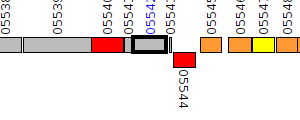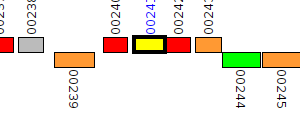In order to generate a more inclusive dataset of Pseudomonas genes mapped to putative in-paralogs and putative orthologs in other Pseudomonas species/strains, we developed a Pseudomonas Orthologous Groups classification system.
To generate ortholog groups, pair-wise DIAMOND searches were run on all genomes in the database to find reciprocal best hits (RBHs) for each gene. These analyses often resulted in multiple candidate genes for RBH status, which were narrowed down by examining the similarity between the query's flanking genes and the hit's flanking genes. If two candidate genes were directly adjacent, they where both accepted as RBHs that involve putative in-parology.
Pairwise intra-genome DIAMOND searches were also performed to acquire in-paralog information (i.e. gene duplications occurring after species divergence). If two genes in one genome were reciprocally more similar to each other than to any gene in the other genomes, the two genes were designated putative in-paralogs. Ortholog groups are built by starting with a seed gene and then adding all genes to which there is a RBH or in-paralog relationship.
Every new gene added to an ortholog group was then treated as a seed gene and the addition process was repeated until all qualifying genes had been added. The result was the development of orthologous groups, specifically generated for Pseudomonas species genomes, which can be used to sort search results.
Pseudomonas Ortholog Group POG000236
| Strain | Locus Tag | Description | Same-Strain Members | Fragment ? | |
|---|---|---|---|---|---|
| Pseudomonas aeruginosa BL09 | Q063_03515 |
oxidoreductase
|
2 same-strain members: Q063_02801 Q063_03515 |

|
|
| Pseudomonas aeruginosa BL10 | Q064_05542 |
oxidoreductase
|
2 same-strain members: Q064_00241 Q064_05542 |

|
|
| Pseudomonas aeruginosa BL10 | Q064_00241 |
oxidoreductase
|
2 same-strain members: Q064_00241 Q064_05542 |

|
|
| Pseudomonas aeruginosa BL11 | Q065_00317 |
oxidoreductase
|
3 same-strain members: Q065_00317 Q065_01906 Q065_04665 |

|
|
| Pseudomonas aeruginosa BL11 | Q065_01906 |
oxidoreductase
|
3 same-strain members: Q065_00317 Q065_01906 Q065_04665 |

|
|
| Pseudomonas aeruginosa BL11 | Q065_04665 |
oxidoreductase
|
3 same-strain members: Q065_00317 Q065_01906 Q065_04665 |

|
|
| Pseudomonas aeruginosa BL12 | Q066_01071 |
oxidoreductase
|
3 same-strain members: Q066_01071 Q066_03192 Q066_04747 |

|
|
| Pseudomonas aeruginosa BL12 | Q066_03192 |
oxidoreductase
|
3 same-strain members: Q066_01071 Q066_03192 Q066_04747 |

|
|
| Pseudomonas aeruginosa BL12 | Q066_04747 |
oxidoreductase
|
3 same-strain members: Q066_01071 Q066_03192 Q066_04747 |

|
|
| Pseudomonas aeruginosa BL13 | Q067_00231 |
oxidoreductase
|
2 same-strain members: Q067_00231 Q067_06124 |

|
|
| Pseudomonas aeruginosa BL13 | Q067_06124 |
oxidoreductase
|
2 same-strain members: Q067_00231 Q067_06124 |

|
|
| Pseudomonas aeruginosa BL14 | Q068_05665 |
oxidoreductase
|
2 same-strain members: Q068_04947 Q068_05665 |

|
|
| Pseudomonas aeruginosa BL14 | Q068_04947 |
oxidoreductase
|
2 same-strain members: Q068_04947 Q068_05665 |

|
|
| Pseudomonas aeruginosa BL15 | Q069_01167 |
oxidoreductase
|
3 same-strain members: Q069_01167 Q069_04185 Q069_04652 |

|
|
| Pseudomonas aeruginosa BL15 | Q069_04185 |
oxidoreductase
|
3 same-strain members: Q069_01167 Q069_04185 Q069_04652 |

|
|
| Pseudomonas aeruginosa BL15 | Q069_04652 |
oxidoreductase
|
3 same-strain members: Q069_01167 Q069_04185 Q069_04652 |

|
|
| Pseudomonas aeruginosa BL16 | Q070_04132 |
oxidoreductase
|
2 same-strain members: Q070_04132 Q070_04800 |

|
|
| Pseudomonas aeruginosa BL16 | Q070_04800 |
oxidoreductase
|
2 same-strain members: Q070_04132 Q070_04800 |

|
|
| Pseudomonas aeruginosa BL17 | Q071_00241 |
oxidoreductase
|
2 same-strain members: Q071_00241 Q071_05856 |

|
|
| Pseudomonas aeruginosa BL17 | Q071_05856 |
oxidoreductase
|
2 same-strain members: Q071_00241 Q071_05856 |

|